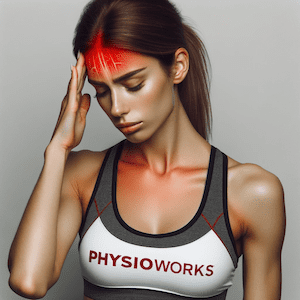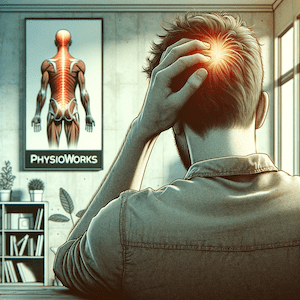Headaches or Migraine
Article by John Miller


Types of Headaches: Understanding the Causes and Red Flags
Dealing with a severe headache or migraine can be highly disruptive and inconvenient for the individual suffering and their immediate family and friends. It is crucial to accurately diagnose the cause of a headache to guide appropriate investigations, treatment, and management of the underlying headache disorder. While migraines are often the culprit, it’s essential to recognise that head pain can have various causes. This article will outline differentiating diagnostic criteria and highlight the red flags that indicate the need for prompt medical attention and further investigation.

Recognising Red Flags: When Should You Be Concerned?
Unfortunately, a small percentage of headache sufferers may experience a more serious underlying condition that requires investigation. These red flags can be vital signs of conditions such as brain tumours, aneurysms, stroke, meningitis, or other systemic illnesses. If you experience any of the following symptoms, it is essential to seek urgent advice from a healthcare professional:
- Your headache is the worst you’ve ever experienced or different from your usual headaches.
- A headache triggered by exertion (e.g., exercise, cough, sneeze, or sex).
- You are over the age of 50 and experiencing headaches.
- Your headache persists despite treatment.
- Your headache has a sudden onset.
- You are experiencing central nervous system findings, such as motor weakness, memory loss, or slurred speech.
- You have a compromised immune system, such as HIV or other immune-related conditions.
- You are experiencing fever or other systemic symptoms like weight loss or rash.
When you have any of the above red-flag symptoms, we strongly recommend consulting your doctor immediately for a thorough investigation.
Less Urgent and Severe Headache Types
Fortunately, most headaches do not require urgent medical investigation and can respond well to treatment based on an accurate diagnosis.
Understanding the Cause of Your Headache or Migraine
Historically, healthcare professionals primarily based the diagnosis of headaches and migraines on whether the head pain pulsed. Pulsatile headaches were classified as migraines, while tension-type headaches were non-pulsatile headaches, even without evidence of increased tension in the scalp or forehead muscles.
Advancements in Headache and Migraine Research
Thankfully, researchers have significantly enhanced our understanding of the sources of headaches. As our knowledge evolves, diagnostic criteria and categorisation will continue to improve. There are over 300 identified causes of headaches and migraines, which is a considerable increase compared to the traditional two options. This wide range of potential causes can make diagnosis and treatment quite challenging.
Among the 300 causes, the most common are migraines, tension-type headaches, and neck headaches. Interestingly, these types can also coexist, further complicating the diagnostic process.
Specific Headache Types
- Migraine
- Tension-Type Headache
- Neck Headache (Cervicogenic Headache)
- Vestibular Migraine
- Jaw Headache
- Concussion
At PhysioWorks, we are particularly interested in assessing and treating migraine and headache disorders. Specifically, we focus on the diagnosis and treatment of neck headaches and jaw headaches. Our headache physiotherapists’ knowledge assists with your diagnosis and guides you to the appropriate healthcare practitioner if necessary.
Conclusion
In conclusion, understanding the cause of your headache or migraine is crucial for effective treatment. While migraines and tension-type headaches are common, many potential causes exist. Recognising red flags and seeking prompt medical attention when necessary can help identify any underlying severe conditions. Consultation with healthcare professionals and specialised practitioners can provide the best guidance and treatment for your headache or migraine disorder.
Rochedale - Call 38410277
Book Online: RochedaleSalisbury - Call 32751044
Book Online: SalisburySandgate - Call 32691122
Book Online: Sandgate 

Article by Matthew Hewitt
Headache Causes
Headaches and migraines, unfortunately common, can greatly affect our lives. Understanding their types and causes is key to effective management and treatment.
Headaches and migraines can stem from a variety of factors. These include conditions related to the neck and jaw. Some specific types you might experience are neck, tension, cluster, and migraines.
Neck-related issues like neck pain, facet dysfunction, and pinched nerves can also lead to headaches. Additionally, jaw conditions such as TMJ pain and dysfunction can cause jaw headaches.
Headache Symptoms Differ
Identifying a headache's location, duration, and intensity can help pinpoint potential causes and effective treatments. This information isn't definitive but helps distinguish possible headache or migraine types.


Common Headache Types
Tension-Type Headaches
Tension-type headaches usually feel like a band across the forehead, extending into the neck. They are continuous, non-pulsating, and may be accompanied by neck or shoulder tenderness, but not nausea or increased sensory sensitivity.
Jaw Headache
TMJ or jaw-related headaches are localised around the jaw and ear, affecting one side. They often come with jaw movement issues, chewing difficulties, or sensations of clicking, locking, and catching in the jaw. TMJ physiotherapists and your dentist are good practitioners to start with to assess and treat your TMJ headache.
Neck Headache
Neck headaches (cervicogenic headaches) are typically a steady, non-throbbing pain at the skull's base, around one eye, or over the top of the head. They may also involve limited neck mobility, but this is not essential. your physiotherapist is best person to see for assessing and relieving your neck headache.
Cluster Headache
Cluster headaches are intensely concentrated around one eye. Accompanying symptoms can include a runny nose, drooping or reddened eye, or increased facial perspiration.
Concussion Headache
Concussion-related headaches resemble migraines with a throbbing sensation and are closely linked to concussions. If these headaches worsen, or if symptoms like slurred speech, seizures, or unusual behaviour occur, seek medical attention immediately.
Sinus Headache
Sinus headaches are characterised by pain, pressure, or fullness from the sinuses, often worsening when bending forward or lying down. They can also cause toothache-like pain or nasal congestion.
Migraines
Migraines often affect one side of the head, involving the entire side of the head and face. They can occur with or without visual disturbances (aura) and include symptoms like nausea and sensitivity to light and noise.
In Conclusion
The causes of headaches and migraines vary, as do their treatments. Consult a healthcare practitioner such as your physiotherapist or doctor for accurate diagnosis and tailored treatment plans. Understanding these differences is essential for effective headache management and relief.
General Information
- Migraine vs Headache
- Specific Migraine - Headache Types
- Neck Headache
- Tension Headache
- Cluster Headaches
- Migraine
- Vestibular Migraine
- TMJ Headache
- Concussion
Headache FAQs
Rochedale - Call 38410277
Book Online: RochedaleSalisbury - Call 32751044
Book Online: SalisburySandgate - Call 32691122
Book Online: SandgateArticle by John Miller
Experiencing a Headache or Migraine?
Understand Your Options
Headaches and migraines are more than just a nuisance; they can significantly disrupt your daily life. When you start experiencing these symptoms, it's imperative to seek medical advice. Doctors often recommend neurological assessments and may suggest a CT or MRI scan. These scans are vital for excluding serious conditions like aneurysms or tumours. Most of the time, fortunately, the results are normal.
What to Do When Your Scans Are Clear
Getting a clear scan result brings a sigh of relief, eliminating concerns about serious underlying causes. Yet, the task of identifying the source of your headaches or migraines remains.
Identifying the Root Cause of Your Headache
At PhysioWorks, we understand that diagnosing the root cause of headaches is a key step in treatment. We primarily focus on three types of headaches:


Understanding Neck-Related Headaches
Researchers feel that about one in four headaches is linked to neck issues. A thorough neck examination by a skilled headache physiotherapist is crucial. In many cases, the physiotherapist can diagnose and begin treating your neck headache from the first consultation.
Neck Headache: A Deeper Insight
Neck headaches, or cervicogenic headaches, often originate from neck joints, muscles, or ligaments. Symptoms include pain starting at the back of the head, radiating forwards, neck stiffness, and sometimes shoulder or arm pain. Physiotherapy techniques like manual therapy, specific exercises, and posture correction can provide significant relief.
Related article: Neck Headaches
Tension-Type Headaches: Understanding and Management
Tension-type headaches, marked by a band-like pain around the head, are frequently associated with stress, poor posture, and muscular tension. Physiotherapy plays a critical role in managing these headaches, offering stress-reduction techniques, ergonomic advice, and exercises to improve posture and muscle function.
Related article: Tension-Type Headaches
TMJ Headaches: The Role of Physiotherapy
TMJ headaches, stemming from jaw joint and muscle issues, present symptoms like facial pain, jaw clicking, and chewing difficulties. Physiotherapists, with a skillset in jaw disorders, offer specialised exercises, manual therapy, and advice to improve jaw function.
Related article: TMJ headaches
Latest Research and Developments
Recent studies underscore the effectiveness of physiotherapy in headache management. Techniques such as dry needling, acupuncture, specific neck and shoulder exercises, posture correction, and relaxation strategies have shown promise in reducing the frequency and intensity of headaches.
Conclusion: Seeking Professional Help
Managing headaches and migraines often requires a targeted approach. Physiotherapy offers a range of treatments customised to your needs. If headaches or migraines are affecting your life, consider consulting a qualified headache physiotherapist. This could be a significant step towards a pain-free life. However, always start with a doctor's consultation to exclude any serious underlying conditions.
Call to Action: Consult a Professional
Don't let headaches dictate your life. Reach out to a headache physiotherapist or your doctor today to embark on your journey to recovery and improved quality of life. Remember, investing in your health is paramount.
What to Do? Seek Professional Advice from Your Physiotherapist
If you're struggling with headaches or migraines, the first step is to consult a physiotherapist specialised in headache management. They can provide a comprehensive assessment and tailor a treatment plan suited to your specific needs, incorporating the latest research and techniques. Booking a consultation can be your first step towards finding relief and regaining control of your life.
Rochedale - Call 38410277
Book Online: RochedaleSalisbury - Call 32751044
Book Online: SalisburySandgate - Call 32691122
Book Online: SandgateRelated Articles
- Neck Headache - This page provides an in-depth look at the causes, symptoms, and treatment options for neck-related headaches, which are often a result of issues with the neck joints, muscles, or ligaments.
- TMJ Headache - Readers will find information on how TMJ disorders can lead to headaches, including symptoms, diagnosis, and treatment options for jaw-related headache issues.
- Tension Headache Relief: Symptoms, Diagnosis, And Treatment: Offers insights into tension-type headaches, including their causes, symptoms, and how physiotherapy can play a crucial role in managing these headaches.
- Migraine - Provides an overview of migraines, discussing their impact, the importance of medical advice, and physiotherapy's role in managing migraine symptoms.
- Cluster Headaches - Understanding And Managing The Pain: This article explores the severe nature of cluster headaches, their symptoms, and the potential for physiotherapy to aid in management and relief.
- Choosing The Right Pillow For Neck Support – Find Relief Now: Discusses how the right pillow can prevent neck pain and headaches, highlighting the importance of neck support for overall well-being.
Additional Information
For more details on specific headache types, migraine comparisons, and frequently asked questions, visit our website for comprehensive guides on:



